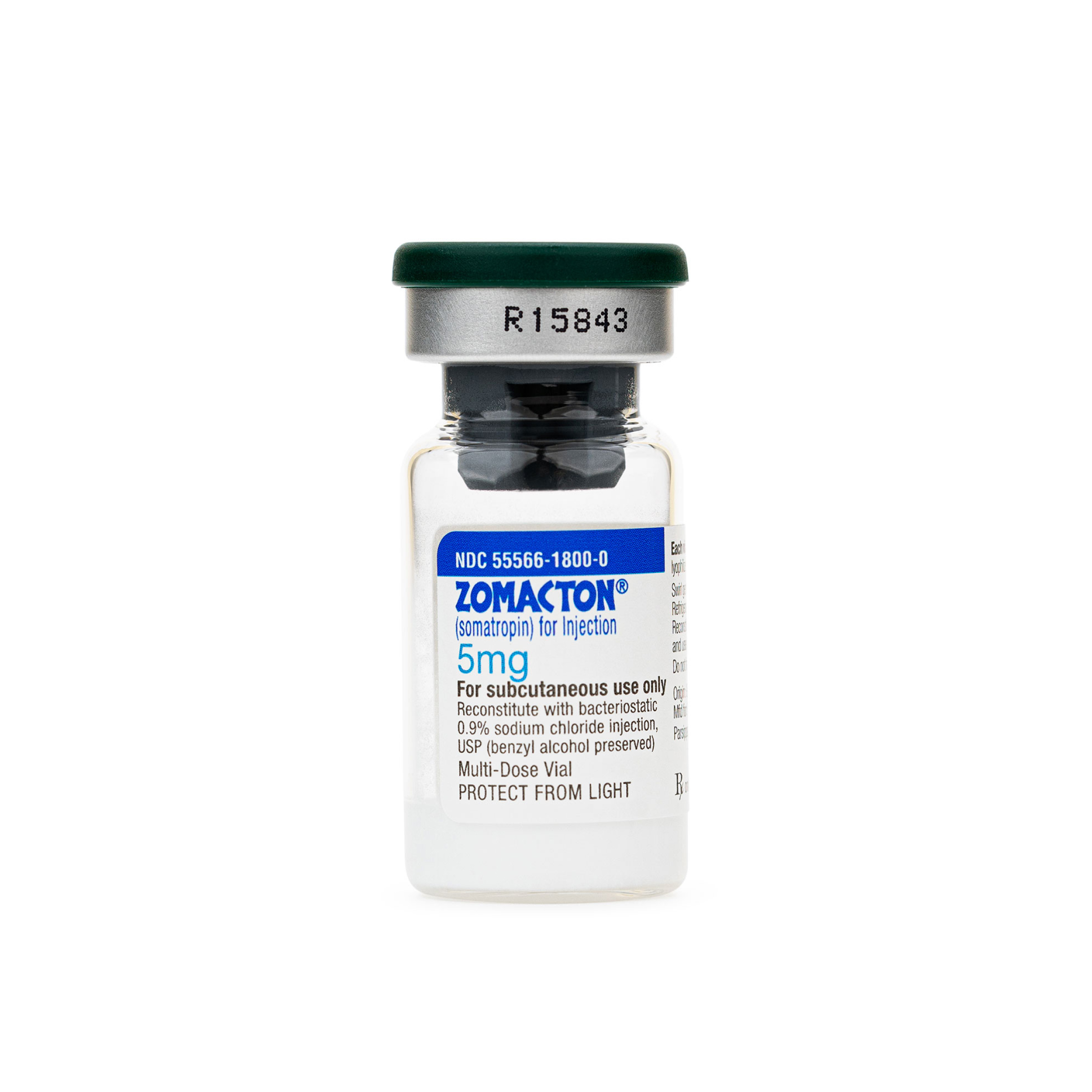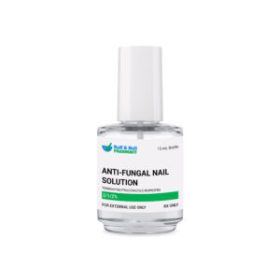Zomacton Injection (Somatropin) (Each) †
† commercial product
Produced using either mammalian cell culture or Escherichia coli, somatropin is a manufactured form of growth hormone known as recombinant human growth hormone (rhGH). The pituitary gland makes human natural growth hormone (hGH). Originally sourced from human corpses, hormones for growth hormone therapy were discontinued once incidents of CreutzfeldtJakob disease were linked to tainted products.
Among a range of conditions, including growth failure, short stature, adult and pediatric growth hormone deficiency (GHD), and short bowel syndrome. wasting associated with cachexia or AIDS. Clinical studies of persons with HIV-related adipose redistribution syndrome (HARS) suggest that somatropin could help lower visceral fat, yet the evidence is still limited and just lasts a few time.
Available are several forms of somatropin, each with particular applications and recommended dosage. Because these products lack automatic interchangeability, careful decision-making is required. Approved by the FDA in 1987 at first, somatropin remains a vital element in the treatment of growth-related and metabolic disorders.
In children and teenagers, natural growth hormone is essential for the correct formation of organs, bones, muscles, and connective tissues. It also significantly impacts metabolism in adults. Binding to growth hormone (GH) receptors and generating a range of physiological effects, recombinant somatropin copies these same biological activities.
Direct effects of somatropin are:
Lowering the peripheral insulin activity and stimulating compensatory insulin release
Encouraging the liver and other tissues to generate insulin-like growth factors (IGFs or somatomedins)
Encouraging the degradation of adipose tissue triglycerides
Raising the liver’s output of glucose
Improving calcium absorption and retention as well as sodium and potassium balance
These direct actions oppose insulin‘s function in fat and carbohydrate metabolism; they are even more aggravated when glucocorticoids are involved.
Mainly via IGFs, which travel in the blood and bind to IGF receptors, indirect effects are negotiated. Two well-known IGFs are IGF1 and IGF2. Growth hormone mainly works via IGF1; IGF2 acts more like insulin.
Among the major anabolic functions of IGFs are stimulating:
Development and multiplication of cells
Amino acid passage into cells
Synthesis of proteins, RNA, and DNA
Particularly crucial for cartilage production (chondrogenesis), bone development, and soft tissue growth, IGF1 It encourages linear height growth by affecting long bone’s cartilage growth plates. Furthermore supporting organ development, erythropoietin activation, muscle cell number and size.
Directly on the gastrointestinal tract or indirectly via systemic and local IGF creation, growth hormone may also improve nutrient, electrolyte, and water absorption throughout. the intestinal wall as revealed in invivo research. When glucocorticoids are present, however, these indirect effects are suppressed.
Somatropin: Contraindications, Safety, and Clinical Notes
According to the research, youngsters with idiopathic growth hormone deficiency or short stature treated with somatropin were roughly 30% more likely to die than the general population. Due of study design restrictions, the FDA decided that the evidence was inconclusive. A Swedish registry study from 2016 indicated that mortality was probably related to underlying patient characteristics—that is, low birth weight and congenital malformations—rather than to the therapy itself.
Laboratory Impacts
Hypersensitivity
Anaphylaxis and angioedema are among the severe systemic reactions that have been observed. In individuals with sensitivity, some formulations have mcresol, glycerin, or benzyl alcohol; different products or diluents should be used. Neonates should not use benzyl alcohol-containing goods because they have a toxicity risk.
Pediatric Concerns
Not advised for promoting growth in children with sealed epiphyses.
Particularly in kids with endocrine problems or fast development, may raise the chance of slipped capital femoral epiphysis (SCFE).
Clinical examination is warranted for hip or knee discomfort or limping.
Children with renal dysfunction should be evaluated for renal osteodystrophy; SCFE or avascular necrosis could appear in late stages.
Neoplasm and Cancer
Not recommended for patients with active cancer.
Patients with unusual genetic syndromes connected to short stature may have a higher baseline cancer risk.
If new neoplastic growth happens, therapy should be discontinued.
Critical Condition
Two clinical investigations on seriously sick patients—postoperative, trauma, respiratory failure—found higher mortality with high-dose somatropin. Thus, under such circumstances it is contraindicated. Its security in replacement therapy during a major illness is still unknown.
Syndrome of Prader-Willi
Because of reports of sudden death, children with PraderWilli syndrome who are very obese or have respiratory impairment should not use somatropin. Prior to treatment, all patients should be tested for airway obstruction and sleep apnea; during treatment, they should be closely monitored. Weight management and infection monitoring are absolutely vital.
– Metabolic Consequences
Somatropin lowers insulin sensitivity, hence in diabetics or those with risk factors (obesity, Turner syndrome, family history of type II diabetes), careful monitoring is needed.
Diabetic retinopathy calls for contraindication.
Adjustments in antidiabetic medications might be needed.
Additional warnings
Scoliosis: Growth acceleration might make curvature worse; follow-up is recommended.
Treatment can reveal adrenal insufficiency or hypothyroidism by affecting adrenal and thyroid performance. Particularly in Turner syndrome, where autoimmune thyroid illness is prevalent, regular monitoring is needed.
Usually within eight weeks of treatment, intracranial hypertension has been reported in certain patients with symptoms including papilledema, headaches, and nausea. Suggested funduscopic examinations.
Turner syndrome: Needs close follow-up; raises heart disease, otitis media, and pancreatitis risk.
Certain Groups
Use only if benefits exceed risks.
Senior citizens are more likely to experience negative consequences (edema, arthralgia, glucose intolerance). Antiaging or athletic use of growth hormone is not advised and is regarded as a possibly inappropriate medication in geriatrics other than as replacement following pituitary removal.
HIV-associated adipose redistribution syndrome (HARS)
In HARS patients, somatropin has been investigated. It looks less effective in women, maybe because of estrogen therapy or lesser starting visceral fat.
Pancreatitis
Constant or intense stomach pain during treatment calls for assessment.
Somatropin: Clinical Effects and Safety Profile
Composition of Bones and Body
Adults with growth hormone deficit (GHD) have been examined for effects on bone mineral density (BMD) and bone mineral content (BMC) using somatropin (Humatrope).
In men with adult-onset GHD, lumbar spine BMD increased 4% compared to placebo; no notable change was observed in women or hip BMD.
Patients in transition treated with 12.5 mcg/kg/day showed a 2.9% increase in overall BMC and major lumbar spine improvement; greater dosages and placebo showed no benefit. Osteoporotic fracture risk has not been assessed.
In adults with GHD, somatropin (Nutropin AQ) has also been found to lower visceral adipose tissue (VAT). VAT fell 14.2% at 32 weeks, although the effect on long-term cardiovascular outcomes is unknown.
possibility of malignancy
Among a few GHD patients treated with somatropin leukemia resulted. Whether this is caused by GH deficit, somatropin, or previous treatments including radiation is unknown.
The impact on intracranial tumor recurrence in adults is unknown.
Should proof of neoplasia become available, somatropin should be stopped. Patients with rare genetic syndromes or unusual nevi have to be under close surveillance.
Edema and Water Retention
Among the most typical side effects: edema
5–45% for adults (brand-dependent).
Children: around 3%.
Generally early, perhaps fleeting, and dose lowering can help. Adults more often have peripheral edema.
– Intracranial Hypertension
Generally within 8 weeks of treatment, reported in a few of individuals. Symptoms: papillary edema, excruciating headaches, nausea, vomits, visual abnormalities. Usually symptoms go away following dose reduction or cessation. Funduscopic inspections are advised initially then on an intermittent basis. Risk increases in Turner syndrome.
Well-controlled clinical trials in pregnant women to establish somatropin’s safety are not now available. Whether this treatment could have negative impacts on fertility, reproduction, or fetal development is still uncertain. No indication of decreased fertility or fetal damage was seen in animal research using higher than the usual human dose. Women of childbearing potential should be warned that the effects of somatropin use during pregnancy in humans are unknown.
Information on the movement of somatropin into human breast milk, its effects on nursing infants, or its impact on milk output is also limited. Small published trials, however, have shown no adverse consequences in breastfed babies when mothers were administered somatropin, nor did they alter milk supply or composition. Clinicians should consider the health advantages of breastfeeding against the possible danger of drug exposure to the infant when prescribing to nursing mothers and chance of not treating the maternal condition.
Store this medication in a refrigerator at 36°F–46°F (2°C–8°C). Keep out of children’s reach. Discard any unused medicine after the beyond-use date. Do not flush or pour into sink or drain.
- Omnitrope (somatropin) package insert. Princeton, NJ: Sandoz, Inc.; 2016 Dec.
- Genotropin (somatropin) package insert. New York, NY: Pharmacia & Upjohn Company; 2016 Dec.
- Food and Drug Administration (US FDA) Drug Safety Communication. Safety review update of Recombinant Human Growth Hormone (somatropin) and possible increased risk of death. Retrieved August 4, 2011. Available on the WorldWide Web at: http://www.f– LinkOpens in New Tab
- Albertsson-Wikland K, Martensson A, Savendalh L, et al. Mortality is not increased in recombinant human growth hormone-treated patients when adjusting for birth characteristics. J Clin Endocrinol Metab. 2016; 101: 2149-2159.
- Humatrope (somatropin) package insert. Indianapolis, IN: Eli Lilly and Company; 2016 Dec.
- Serostim (somatropin) package insert. Rockland, MA: EMD Serono, Inc.; 2017 May.
- Nutropin (somatropin) package insert. San Francisco, CA: Genentech; 2016 Dec.
- Accretropin (somatropin) package insert. Winnipeg, Canada: Cangene Corporation; 2016 Dec.
- Nutropin AQ (somatropin) package insert. San Francisco, CA: Genentech; 2016 Dec.
- Saizen (somatropin) package insert. Rockland, MA: EMD Serono Inc; 2017 May.
- Norditropin (somatropin) package insert. Plainsboro, NJ: Novo Nordisk; 2016 Dec.
- Zomacton (somatropin) package insert. Parsippany, NJ: Ferring Pharmaceuticals, Inc; 2016 Dec.
- Zorbtive (somatropin) injection package insert. Rockland, MA: EMD Serono, Inc.; 2017 May.
- Cook DM, Yuen KC, Biller BM, et al; American Association of Clinical Endocrinologists (AACE). American Association of Clinical Endocrinologists medical guidelines for clinical practice for growth hormone use in growth hormone-deficient adults and
- The American Geriatrics Society 2015 Beers Criteria Update Expert Panel. American Geriatrics Society updated Beers Criteria for potentially inappropriate medication use in older adults. J Am Geriatr Soc 2015;63:2227-46.





